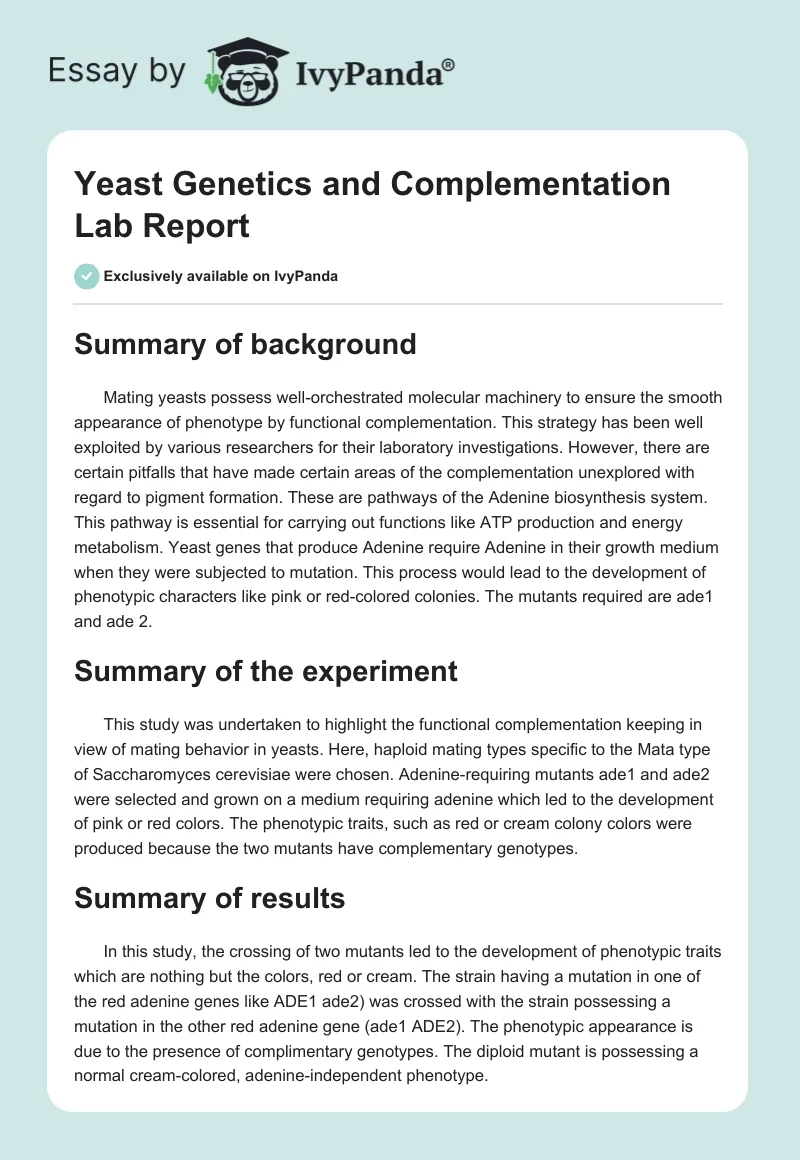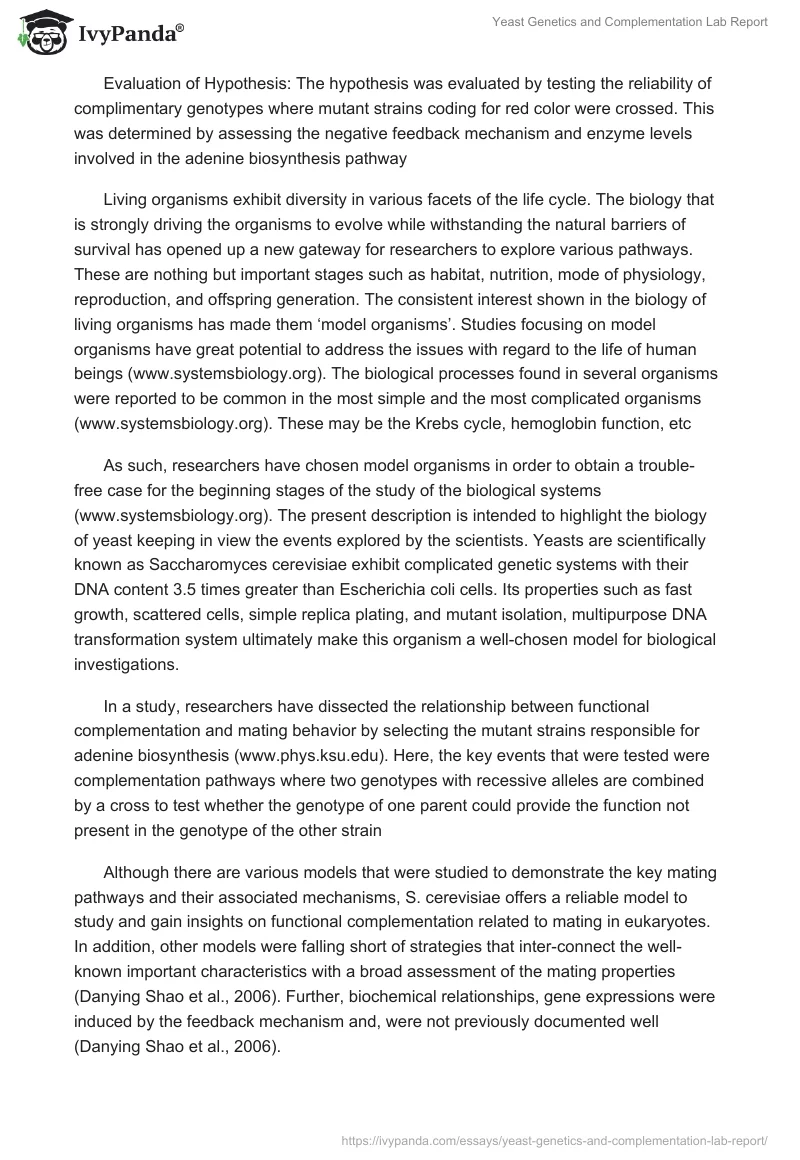Summary of background
Mating yeasts possess well-orchestrated molecular machinery to ensure the smooth appearance of phenotype by functional complementation. This strategy has been well exploited by various researchers for their laboratory investigations. However, there are certain pitfalls that have made certain areas of the complementation unexplored with regard to pigment formation. These are pathways of the Adenine biosynthesis system. This pathway is essential for carrying out functions like ATP production and energy metabolism. Yeast genes that produce Adenine require Adenine in their growth medium when they were subjected to mutation. This process would lead to the development of phenotypic characters like pink or red-colored colonies. The mutants required are ade1 and ade 2.
Summary of the experiment
This study was undertaken to highlight the functional complementation keeping in view of mating behavior in yeasts. Here, haploid mating types specific to the Mata type of Saccharomyces cerevisiae were chosen. Adenine-requiring mutants ade1 and ade2 were selected and grown on a medium requiring adenine which led to the development of pink or red colors. The phenotypic traits, such as red or cream colony colors were produced because the two mutants have complementary genotypes.
Summary of results
In this study, the crossing of two mutants led to the development of phenotypic traits which are nothing but the colors, red or cream. The strain having a mutation in one of the red adenine genes like ADE1 ade2) was crossed with the strain possessing a mutation in the other red adenine gene (ade1 ADE2). The phenotypic appearance is due to the presence of complimentary genotypes. The diploid mutant is possessing a normal cream-colored, adenine-independent phenotype.
Evaluation of Hypothesis: The hypothesis was evaluated by testing the reliability of complimentary genotypes where mutant strains coding for red color were crossed. This was determined by assessing the negative feedback mechanism and enzyme levels involved in the adenine biosynthesis pathway
Living organisms exhibit diversity in various facets of the life cycle. The biology that is strongly driving the organisms to evolve while withstanding the natural barriers of survival has opened up a new gateway for researchers to explore various pathways. These are nothing but important stages such as habitat, nutrition, mode of physiology, reproduction, and offspring generation. The consistent interest shown in the biology of living organisms has made them ‘model organisms’. Studies focusing on model organisms have great potential to address the issues with regard to the life of human beings (www.systemsbiology.org). The biological processes found in several organisms were reported to be common in the most simple and the most complicated organisms (www.systemsbiology.org). These may be the Krebs cycle, hemoglobin function, etc
As such, researchers have chosen model organisms in order to obtain a trouble-free case for the beginning stages of the study of the biological systems (www.systemsbiology.org). The present description is intended to highlight the biology of yeast keeping in view the events explored by the scientists. Yeasts are scientifically known as Saccharomyces cerevisiae exhibit complicated genetic systems with their DNA content 3.5 times greater than Escherichia coli cells. Its properties such as fast growth, scattered cells, simple replica plating, and mutant isolation, multipurpose DNA transformation system ultimately make this organism a well-chosen model for biological investigations.
In a study, researchers have dissected the relationship between functional complementation and mating behavior by selecting the mutant strains responsible for adenine biosynthesis (www.phys.ksu.edu). Here, the key events that were tested were complementation pathways where two genotypes with recessive alleles are combined by a cross to test whether the genotype of one parent could provide the function not present in the genotype of the other strain
Although there are various models that were studied to demonstrate the key mating pathways and their associated mechanisms, S. cerevisiae offers a reliable model to study and gain insights on functional complementation related to mating in eukaryotes. In addition, other models were falling short of strategies that inter-connect the well-known important characteristics with a broad assessment of the mating properties (Danying Shao et al., 2006). Further, biochemical relationships, gene expressions were induced by the feedback mechanism and, were not previously documented well (Danying Shao et al., 2006).
Therefore, this study was chosen to better address the events that remained unanswered earlier. The results were tested because two alternative alleles of the MAT gene — MATa and MAT alpha specific to yeast, determine the two opposite mating types (www.phys.ksu.edu). This is because these genes are considered easier for studying mutation with regard to the biosynthesis of purines and pyrimidines that form the backbone of nucleic acids (www.phys.ksu.edu). Here, adenine biosynthesis was tested by selecting ade1 and ade2 which were reported to be the first discovered two adenine-requiring mutants (www.phys.ksu.edu). It is not known well whether the crossing of two mutant strains could induce the subsequent changes in Adenine biosynthesis by feedback mechanism and phenotypic appearance of red or cream-colored colonies. The hypothesis was based on the fact that cells heterozygous for red adenine mutations like ADE1/ade1 or ADE2/ade2) produce white-colored colonies and cells homozygous for recessive alleles (ade1/ade1 or ade2/ade2) produce red colored colonies (www.phys.ksu.edu). During the process of mitotic segregation of red plaques develop in white colonies. This strategy was better exploited by the functional complementation test. It was reported that the haploid cells of several mating types when crossed together would produce a diploid cell (www.phys.ksu.edu). This diploid cell contains the genotype enough to provide the alleles required for the adenine synthesis that are missing in the other counterpart (www.phys.ksu.edu). Hence, two strains ade 1 and ade 2 were selected and crossed in order to produce adenine which was better assessed by the phenotypic appearance.
References
Danying Shao, Wen Zheng, Wenjun Qiu,Qi Ouyang, Chao Tang. “Dynamic Studies of Scaffold-Dependent Mating Pathway in Yeast.” Biophys J. 91.11 (2006): 3986–4001.
Fred Sherman. “An Introduction to Genetics and Molecular Biology of Yeast.” 2000. Web.
“Genetics of Baker’s Yeast.” Web.
“Using Model Organisms.” 2008. Institute for Systems Biology. Web.


